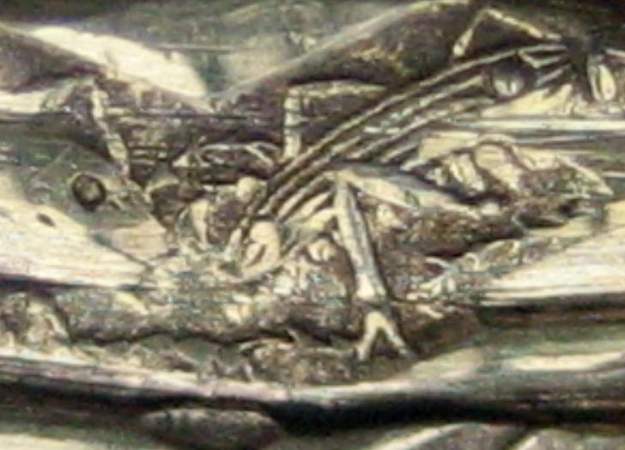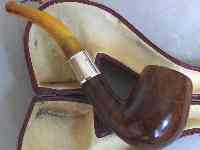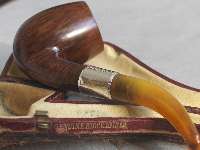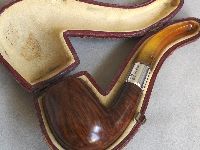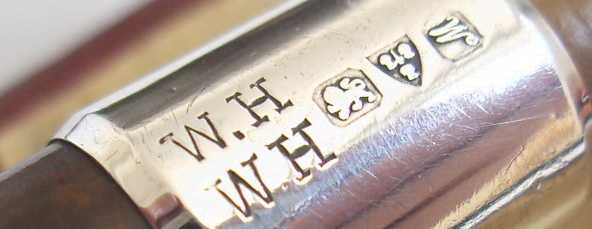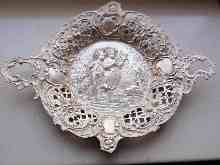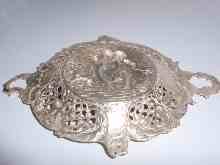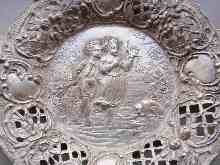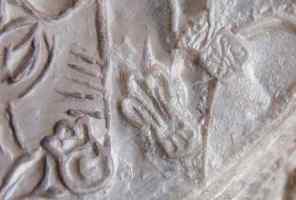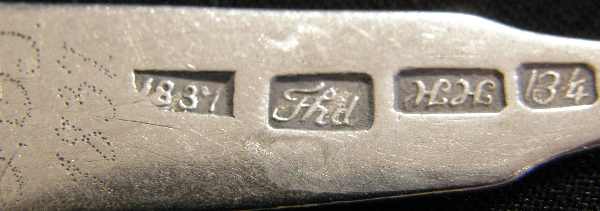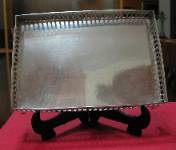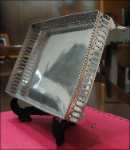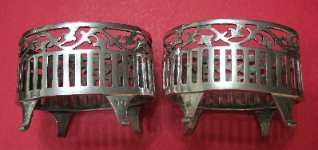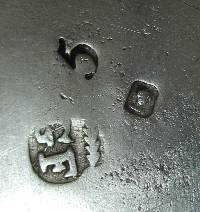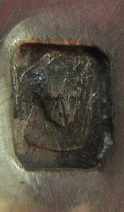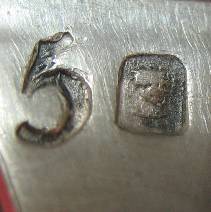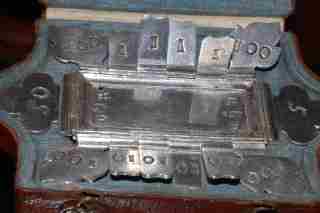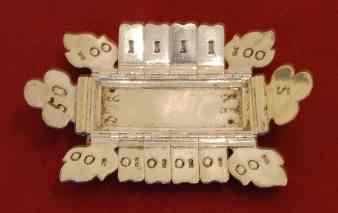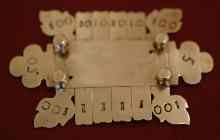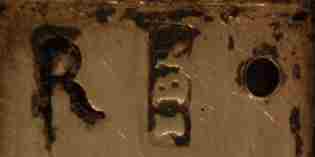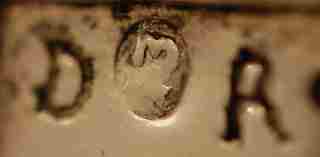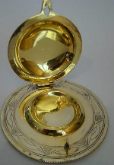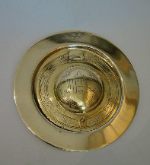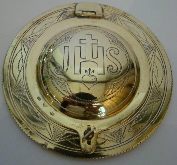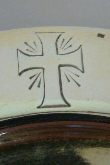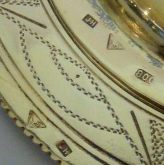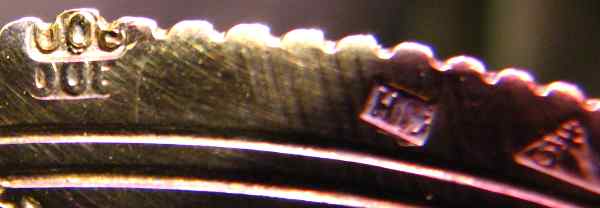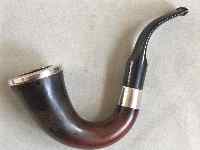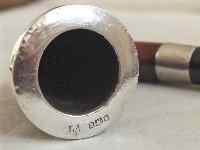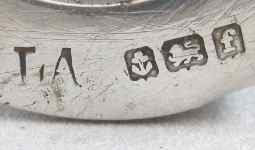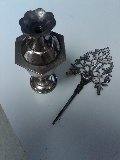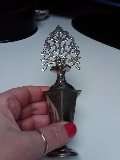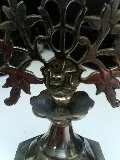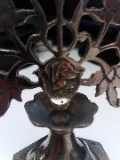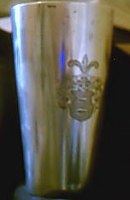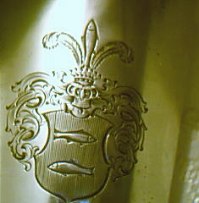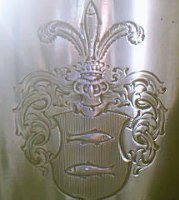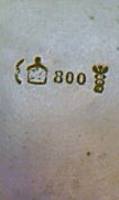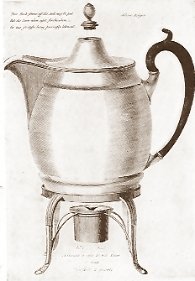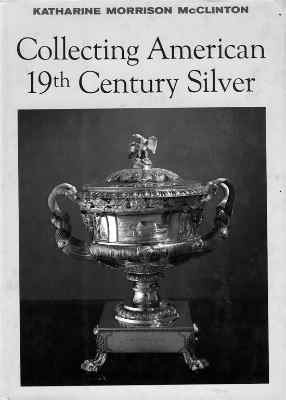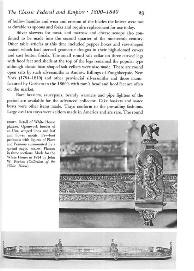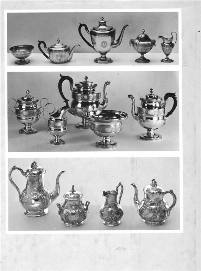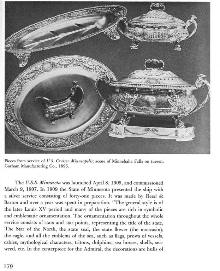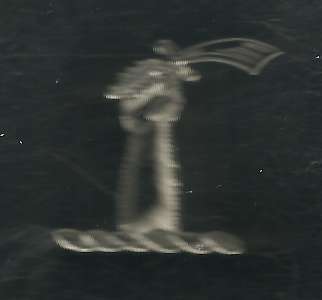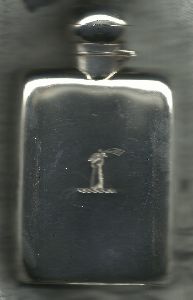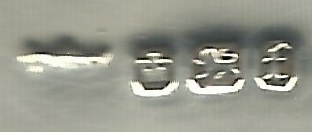 newsletter
# 83 April 2011 newsletter
# 83 April 2011www.ASCASonline.org SITE MAP email: silverassociation@yahoo.it |
||||||||||||||
A new article for ASCAS website
New membersWelcome to new ASCAS members:Andrea De Vita - Italy
|
|
top page -
page map |
Members' Window # 83
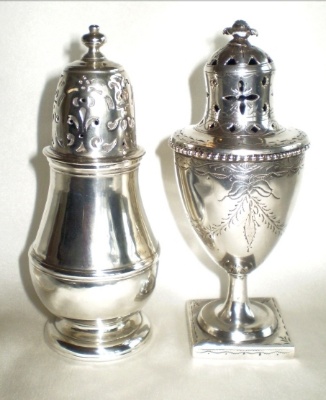
Maria Entrup-Henemann
presents:
|
Mail to ASCAS: e-mail silverassociation@yahoo.it
Piero Eduardo writes:
... Dear George,
another lucky find! An old pipe Axfin (a mark completely unknown
to me!) with pure amber mouthpiece. I need your help to identify
the maker of the silver mount (mark WH WH, without frame,
Chester Assay Office 1912). This maker is not quoted in your
site and I think you can possibly add this mark as "unidentified".
Thank you in advance for your help.
Cordially
Piero
I do not find any WH over WH mark entered in Chester Assay
Office. I believe that, in this case, we are in presence of a
double struck of the mark W.H. If this hypothesis is correct,
the maker would be William Harrison (many addresses in London)
who entered very similar marks in Chester between 1907 and 1912.
William Harrison is quoted as "silversmith" in Chester register,
but one of his marks was presented to registration by Imperial
Tobacco Co. The mark WH is illustrated in my web site at
http://www.silvercollection.it/DICTIONARYTOBACCONISTW.html
Giorgio Busetto
A.de Jong writes:
... I have a silver item from the 18th century but I do not know
what the marks mean.
Would you be so kind to tell me the meaning of these hallmarks?
I hope you can help me
A.de Jong
The mark is not 18th century, but Hanau (Germany) end 19th
century. The maker is, possibly, Wolf & Knell, founded 1887.
Giorgio Busetto
Karen A. Lottie writes:
... Perhaps you can steer me to a resource (possibly yours with
more instruction) which can tell me more about this hallmark on
a teaspoon distinctly marked 1837.
Thank you.
Karen A. Lottie
Claudio Morelli writes:
... Caro Giorgio, another question for you and our friends of
ASCAS.
I'm unable to identify the marks on this tray and salt cellars.
The dimensions of the tray are 19 x 13 cm with a weight of 390
grams.
Thanks for your help.
Claudio
Philippe d'Arschot writes:
... I send you a question for the next newsletter:
I have found a very unusual silver object. Maybe it could be a
counter for an old card game, but I will be happy to have other
opinions.
Dimensions: 9 x 6 cm
4 small feet on the reverse
All the small plates on the sides can be raised or lowered
Best regards.
Philippe d'Arschot
Replies to questions
John Alejandro
receives these answers about his silver pyx
(see March 2011 Newsletter)
Werner Lack writes:
... The shown mark is from former Tschechoslovakia, in use
since Jan. 1st 1929 - for silver content 800 (Tardy p. 399)
Kind regards
Werner
Adam Goldsmith writes:
... The triangular mark with the ‘5’ in it on John
Alexandro’s pyx and paten is the Czechoslovakian 800 purity mark
used between 1929 and 1940. Hope this helps.
Adam Goldsmith
David Nikogosyan writes:
... The image inside the triangle relates to the famous
cross of Slovakia (see for example Slovak eurocoins). Therefore,
my suggestion that these marks are related to the first Slovak
state (1939-1945).
See attached is the scan of 2-euro Slovakian coin.
Regards,
David Nikogosyan
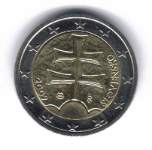
Karin Sixl-Daniell writes:
...the item originated in the Czechoslovakia as it bears the
Czechoslovakian hallmark denoting 800 fineness used from 1929
onwards (I am not sure how long this mark was used for, if I am
not wrong it was until 1942). Unfortunately, I am unable to shed
more light on the maker.
Karin
Maja Houtman and Janjaap Luijt write:
...John Alejandro asked about the mark with the hill, cross
and five in a triangle. It is struck in Czechoslovakia between 1
January 1929 and 30 January 1942. It stands for 800/1000 silver
Met vriendelijke groet,
Maja Houtman and Janjaap Luijt
Piero Eduardo
receives this answer about his pipe with silver mounts
(see March 2011 Newsletter)
Les Salvage writes:
... I contacted Birmingham Assay office about Piero
Eduardo's pipe and received this information today.
The 'LA' Sponsor Mark on the pipe belonged to Louis Adler, a
merchant from London, first registered the mark in 1897, the
mark on the pipe is from 1905'.
Best Regards,
Les Salvage
Joy Aumiller
receives this answers about her silver bottle
(see March 2011 Newsletter)
Chitra Balasubramaniam writes:
... I write about the object presented by Joy Aumiller - I
think is a surma dani - or Kohl liner. The black powder inside
it might by Kohl used to line the eyes with.
Itar dhan (essential oil based perfumes) or Perfume holders are
also shaped like this. But if it has black powders it could be
surma dani (surma meaning kohl for the eyes) and dan or dani
meaning container. It is used extensively in the Middle East,
Egypt....
The little pointed stick is what the kohl is lined with. Kohl is
also made by traditional methods, at home in many parts.
Warm Regards
Chitra
Luis Castelo Lopes writes:
... Your small bottle is a 'makhala' or a 'kohl' container,
and these were/are used by ladies to "paintquot; the make-up
around the eyes (or eyeliner), in a number of Arab countries.
Kohl is the black powder used as eye paint.
I have found a similar piece in a market in Cairo this January.
They are made either of silver or plated metal. The models are
always very similar. As I can not see a clear enough photo of
the marks I can not help you with that. As for the date of the
piece, as far as I know the model has been the same for the last
200 years at least.
I hope this is of some help.
Best regards
Luis Castelo Lopes
Maja Houtman writes:
... Joy Aumiller has this bottle, I think it might be a
bottle for kohl, the black powder women (used to) put around
their eyes in Northern Africa and the Middle East. The design of
the finial and (maybe) Arabic letters on it make me think this
way.
met vriendelijke groet,
Maja Houtman
David March receives
this answers about his German beaker and its crest
(see March 2011 Newsletter)
Pierre Strobbe writes:
... The arms are those of the family Wostrowsky von Skalda
und Witzab. Bohemia, Moravia, Silesia:
"De gueules à deux poissons d'argent l'un sur l'autre .
cimier: un poisson d'argent en pal, la tête en bas".
(two silver fish on a red background)
This piece has a hallmark from Germany
Greetings
Pierre
Karin Sixl-Daniell writes:
... In response to David March's German beaker, here is some
information about the maker's mark:
it refers to Behnisch & Co, Berlin. I have no information on the
coat of arms as of yet.
Karin
"A PAGE per MONTH"
In this column we present a page
obtained from makers' brochures, books, auction catalogs,
advertising or whatever other printed paper, related to silver,
that may be of interest for ASCAS members.
The images will be published at a "low resolution" level and for
private and personal use only
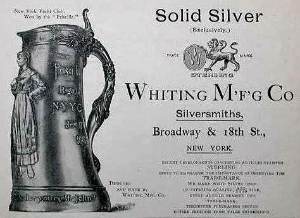
|
This month ASCAS presents an 1895 advertisement ofWHITING M'F'G CO
|
"A WORD per MONTH"
In this column we
present an abstract from a page of the "What is? Silver
Dictionary"
courtesy of


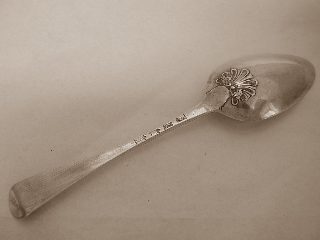
|
HANOVERIAN SPOONThe "Hanoverian" is the most important British
flatware pattern in the 18th century. In this pattern
the stem widens gradually toward the curved terminal and
then turns upward.
|
"A SILVERSMITH per MONTH"
In this column
we present marks, information and history of silversmiths and
silver manufacturers.
This column is published under the kind permission of Giorgio
Busetto's website


THOMAS BRADBURY & SONS LTDThe business traces its
origin to Fenton, Creswick & Co, a partnership involving
Matthew Fenton (an apprentice of Thomas Law), Richard
Creswick and William Watson. They were active as
silversmiths and Sheffield platers and were among the
first to enter their mark at the Sheffield Assay Office
in 1773.
|
"A BOOK ON MY SHELF"
In this column we present books, new
or ancient, dealing with silver in all its aspects (history,
marks, oddities...). This isn't a "book review" but only a fair
presentation of some useful "tools" that anyone may have in the
shelf of his bookcase.
ASCAS members are invited to contribute to this column
(click to enlarge images)
In the "book on my shelf" of this month Karin Sixl-Daniell presents:
"A CREST per MONTH"
In this column we present images and descriptions of Crests and Mottoes of British, Irish and Scottish families as engraved on silver items.

Custom Search
Closing our April 2011 edition of ASCAS Newsletter I hope you have appreciated its content.
Your comments, suggestions and advices will be of great help.
My thanks to Chitra Balasubramaniam, Philippe d'Arschot, A.de Jong, Jayne Dye, Piero Eduardo, Maria Entrup-Henemann, Adam Goldsmith, Maja Houtman, Werner Lack, Luis Castelo Lopes, Karen A. Lottie, Robert Massart, Claudio Morelli, Prof. David N. Nikogosyan, Les Salvage, Karin Sixl-Daniell and Pierre Strobbe for their invaluable contributions.
Giorgio Busetto
Secretary
ASCAS is a community of people having a common
interest in antique silver.
|

